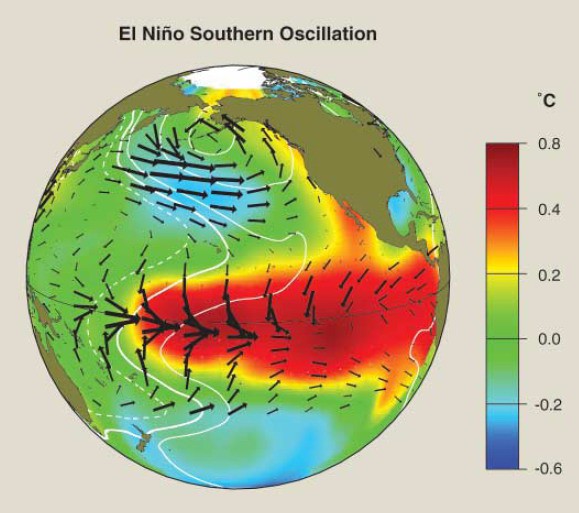

Visualization of El Nino (NOAA)
Early signs of an impending El Niño are beginning to stack up. While the prediction is still somewhat uncertain, the Washington Post recently reported that the conditions may be setting up for very strong El Niño conditions.
The Post article states, “Eric Blake from the National Hurricane Center and Paul Roundy from SUNY-Albany, who see early indicators reminiscent of the development stages of past whopper El Niño events…. So impressed by the strong and persistent westerly winds, Roundy told Freedman he thinks there’s “around” an 80 percent chance of an unusually strong El Niño.”
El Niño conditions usually mean wet, stormy winters for California while the PNW and East Coast tends to be mild with a diminished Atlantic hurricane season.
Here's a primer on the mechanics of an El Niño event.
The storms and large surf conditions associated with past El Niños has led to severe coastal erosion along the California coastline.
According to UC Santa Cruz experts, “We found that 75 percent of the shoreline erosion and damage has occurred during El Niño winters, and the moderate to high-intensity El Niños do most of the damage.”
While El Niño winters can create a lot of erosion, beaches can actually recover pretty rapidly and the associated heavy rains flush a lot of sediment to the coast that helps naturally replenish beaches.
Unfortunately, the short term reaction is to armor the coast with revetments and seawalls. While these structures can provide temporary protection to coastal property, they ultimately lead to the destruction of the public beach and loss of beach access.

Even worse, many of these shoreline armoring structures are awarded emergency permits, which eliminates thorough environmental review and public input. Once granted emergency permits these seawalls are very difficult to remove. A case and point is the Broad Beach seawall in Malibu, CA. This 4,100 foot long revetment is severly limiting beach access and there is resistance to removing the revetment.
This is how the California Coastal Commission defines an emergency: “Emergency” shall mean a sudden, unexpected occurrence demanding immediate action to prevent or mitigate loss or damage to life, health, property, or essential public services.
If there are already early warning signs of El Niño conditions and we have a clear record of those impacts on the coast in the past, what about this winter's potential storms or coastal erosion should be considered “sudden” or “unexpected”?
It should also be noted that there is some evidence that climate change may increase the frequency of El Niño events.
Given climate change, sea level rise, predicted El Niño events and observations on coastal erosion, there should be no “emergencies.” If the El Niño conditions persist and strengthen we know what we are in for. The larger question is, what is our long term strategy to avoid these very well understood problems in the future?